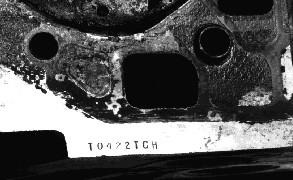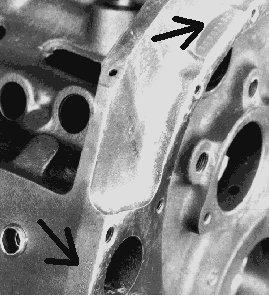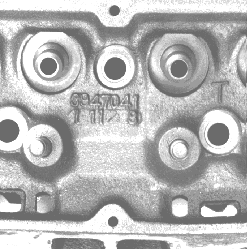Chevy V8 Casting Number Locations (Part 2)
Engine Assembly Date / Suffix Code
The engine assembly date is a "stamped in" code that is stamped into the metal as opposed to a "raised" casting. These date codes are can be found in a number of locations on the block, but most often are found on a ledge that is visible when the motor is assembled. This ledge is found on the passenger side of the block deck at the front. If your alternator is on the passenger side of the motor, the ledge on the block deck is right below it. You may have to move the alternator to be able to read this engine assembly code. Some blocks have the engine assembly code on a flat portion of the block above the timing cover mating surface on the front of the block.
Some very early smallblocks from the mid 1950 model years had an Engine Assembly Date which only included the last two digits of the year. It might look something like "F56FG". On later model engines the engine assembly code looks similar to this "T0422TR". In this case the first letter "T" stands for an engine factory Tonawanda. Your's might have an "F" or "V" for Flint, MI. The next two digits stand for the month of the year, in this example "04" or the fourth month April. The "22" stands for the 22nd day of the month. So what do we have so far in this example? The motor was assembled at the Tonawanda factory on April 22nd. The years are not given. In the 50's and 60's, Chevy used a Roman numeral " I " for the number " 1 " in these engine assembly dates. Don't mistake this for a capital letter "I". What we have left is the "suffix code" which in this example is "TR". Chevy used one to three letters of the alphabet to code the type of engine, transmission and vehicle into the suffix code.
In later years, parts of the Vehicle Identification Number (V.I.N.) were also added before or after the Engine Assembly Date/Suffix code. In that case you might see "T0422TR 1123456789" stamped into the pad on the front passenger side of the block. Sometimes the engine V.I.N. was stamped into a different area of the block on the flange edge of the rear of the block, near the bellhousing mating surface. Sometimes the stamping is found above the timing cover mating surface on the front of the block.


Some of the Engine Suffix letter code combinations were used a number of times. For example, in 1974 the suffix code "CMR" was used on three different vehicle models with the same engine and transmission combinations. "CMR" was again used in '78 with a Corvette and a different engine/transmission combination. You would need to look at the block casting date to know which year the block was made to narrow down the possibilities. Relying solely on the suffix code to identify the original use of the block can be misleading. You need to look at ALL of the casting identifiers before making your determination. Deciphering VIN numbers, trim tags and original factory documentation can also help. If you need help decoding the suffix codes, just email us.
There is another type of stamping found on some blocks. This is the "CE" code. You might see something like this "CE123456" on the front pad of the block deck on the passenger side. The "CE" which alternatively has been known to stand for "Chevrolet Engine" or "Crate Engine" was used on blocks that were warranty replacement motors. The "CE" prefix was also used on "over the counter" blocks and engines. If a customer had problems with his original motor, while it was under warranty, it was replaced with an engine that was stamped "CE" with a number of numeral digits following it which serialized that particular engine. Likewise if a purchaser bought a new motor from the Chevrolet Parts counter, the front pad on the pasenger side of the block may have been stamped with a "CE" code.
A number of crate motors made by GM in Mexico, may have an "M" or "ML" prefix stamped into the front pad of the block followed by a series of numbers which serialize that particular crate replacement motor. You may also see a raised casting on the block or heads of "Hecho en Mexico" which means "Made in Mexico". Many of the new GM crate motors are being made in Mexico. Later model crate engines, sold over the counter by Chevrolet or GM Performance Parts, may have different prefix code identifiers stamped in to the front pad on the block, such as "ZZ3" or three letter codes such as "XXA".
The motors built in the McKinnon factory in Canada will have a "K" indicating the engine assembly plant.
There are two other things to keep in mind. If the block has been previously "decked" by a machine shop, the engine assembly date and suffix codes, normally found on the passenger side front deck of the block, may have been removed by the machining process. They will be gone. Second, some blocks have been "restamped" in order to "create" a "numbers matching" vehicle. With the increase in value of many "numbers matching" collector cars, some folks have "restamped" the blocks to deceive buyers. BE CAREFUL! Check out some of the books listed below. They can help you determine if the vehicle is a "numbers matching" original car or not.
Chevy V8 Head Casting Number Locations
Chevy smallblock and big block cylinder heads have the CASTING NUMBER and the CASTING DATE located in the rocker arm valley. These numbers are found after removing the valve cover on the head.

Some cast iron heads have the casting number on the underside of an intake runner. Some aluminum heads have the casting date on the underside of an intake runner. The casting number of the cylinder head follows the same form as those found on blocks. There will be six to eight digits for the casting number. The head casting date will have a letter for the month and numerals for the day of the month and the year of the decade. Some head casting dates will give the decade and year. In the picture above, the casting number is shown with the casting date right below it. On other head castings the casting date may be in a different location in the rocker arm valley and is not always right below the casting number. Look at all of the features on the heads to help determine which casting you have and when it was made.
Other Block Markings
There are other things found when you stare at these parts and casting identifiers for a while. On big blocks, you may see the words "HIPERF", "HIPER", "TRUCK", "M.TRUCK", "PASS", "MAR" or "MARINE" cast into the block. You may see one or a combination of some of these words. First let me say that "HIPERF" or "HIPER" was used on ALL '65-'91 Mark IV big block blocks and is not an indication that it has four bolt main caps and was used in a high performance application. Two-bolt, low performance big blocks received the same "HIPERF" designation. (In this regard, keep in mind that ALL '91 and later Gen.V and Gen.VI big blocks come with 4-bolt main caps. The two-bolt big blocks are no longer in production.) These same words can be found on the head castings also. Usually the "HIPERF" casting on a head indicates a rectangular port head, but I have found one large oval port head with "HIPERF" showing in the rocker arm valley. This was head casting number 14092359 and was off of an '87 tall deck 427 truck motor.\
"CONV" is just a foundry mark and is NOT an indicator that the motor was originally installed in a convertible.
"CFD" is an abbreviation for the CENTRAL FOUNDRY DIVISION.
Often you will find the last three digits of the block casting number cast in various places around on the cylinder block.
Some of the Gen.1 smallblock motors used blocks with an additional 1% tin and an additional 2% nickel added to the cast iron alloy. These desirable blocks can be identified by looking at the block face under the timing chain cover for "010" AND "020". These designators can also sometimes be found on the rear face of the block inside the perimeter of the bellhousing mating surface.
Casting Number Books and Publications
There are some great books out there that can help you determine which parts were used in particular years with a particular vehicle. If you are interested in a "numbers matching" vehicle and are concerned with the "originality" or the original factory installed use of a particular engine and parts check out the following:
- "Chevy Small Block Suffix Codes 1955-1999" by Mark S. Allen, published by
MSA-1, Inc., P.O. Box 427, Pleasant Hill, MO, 64080. There are three other pocket guides offered including the
"Chevy Small Block 1955-1999 Factory Part & Casting Number Guide", "Chevy Big Block Suffix Codes 1965-1999" and the "Chevy Big Block 1965-1999 Factory Part Number & Casting Number Guide." These four books do include passenger,
truck, marine and industrial engine applications.
- "Chevrolet by the Numbers, the Essential Chevrolet Parts Reference" by Alan L. Colvin, published by Bentley Publishers. There are currently four volumes covering the period from 1955 to 1975. Only V-8 passenger cars are covered, does not include truck, marine or industrial engines. Does include transmission identifiers. They are available over the internet, in bookstores and from your nearest Chevrolet dealer parts counter.
- "Chevy V-8 Engine Casting Numbers 1955-93 and stamped numbers", compiled by the staff at Cars & Parts magazine, published by Amos Press, Inc. in 1994. This volume is available over the internet and in bookstores.
- "The Genuine Corvette Black Book 1953-1998" by Michael Antonick,
Published by Michael Bruce Associates, Inc. Updated yearly, is a pocket
size reference to Vette casting numbers, engine suffix codes, RPO numbers, model year options
and production numbers.
- "The Genuine Camaro White Book 1967-1997" by Michael Antonick,
Published by Michael Bruce Associates, Inc. Updated yearly, is a pocket
size reference to Camaro casting numbers, engine suffix codes, RPO numbers, model year options
and production numbers.
Other books concern themselves with parts "interchanges". These are slightly different than those listed above. These parts "interchange" reference texts relate which parts are similar or have similar features which will interchange with other parts even though they may have different casting numbers or part numbers. A part made in one model year for a vehicle MAY interchange with a part made for a different vehicle made in another model year. Some of the better ones are listed below:
- Hollander Interchange (website no longer works) - reference books for
all types of auto parts interchanges.
All of the above listed reference books and hundreds of others about Chevrolet are available from Amazon.
We appreciate the support and encouragement we have received from our visitors around the world for the past 20 years. Don't forget to follow us on Facebook, and if you run a website or write for a blog, please link to our site!
